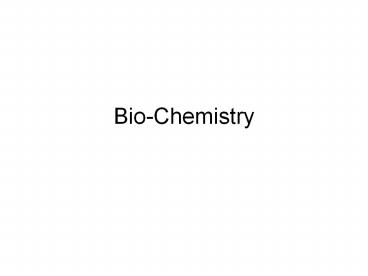Bio-Chemistry - PowerPoint PPT Presentation
1 / 8
Title:
Bio-Chemistry
Description:
... tension Capillary action Surface tension Water has high specific heat/ high heat of vaporization Water is the universal solvent Ice floats because it ... – PowerPoint PPT presentation
Number of Views:61
Avg rating:3.0/5.0
Title: Bio-Chemistry
1
Bio-Chemistry
2
Energy and Metabolism
- Metabolism- sum of all the chemical activities
taking place in an organism. Two types anabolism
and catabolism - Anabolism complex molecules are synthesized from
simpler substances - Ex. Linking amino acids to form proteins
- Endergonic and requires ATP or some other energy
source to drive them - Ex. Dehydration synthesis
- Endergonic reactions are
- exothermic reactions (energy released)
- PE of products is less than the
- PE of reactants
Activation energy
3
- Catabolism- releases energy by splitting complex
molecules into smaller molecules - Ex. Polysaccharides? monosaccharides
- Exergonic reaction releases energy, from higher
to lower free energy - Ex. Hydrolysis
- A chemical reaction would be endothermic if the
amount of free energy of the products is less
than that of the reactants
4
Protein structures
- Primary
- Secondary
- Tertiary
- Quaternary
5
Proteins
- Actin- the protein of which microfilaments
consist. Actin, together with protein myosin, is
responsible for muscle contraction - Actin filaments- thin filaments
- Myosin
- Insulin
- Pepsin
- Aquaporins
- ATP synthase
- Hemoglobins
6
Enzymes
- Biological catalysts
- Proteins, RNA, and ribozymes
- Increase rate of reaction
- Do not enter reaction
- Reduce activation energy
- Required for most biological reactions
- Substrate- reactant which binds to enzyme,
enzyme-substrate complex temporary - Product- end result of reaction
- Active site enzymes catalytic site
- Induced- fit model
- Enzymes have allosteric sites to which an
allosteric regulator binds, changing the enzymes
activity. - Feedback inhibition
- Reversible inhibition- noncompetitive and
competitive - Irreversible inhibition
- Enzymes are specific
- Enzymes have an optimal temperature and pH
- Enzymes require cofactors coenzyme A
- Enzymes lowers a reactions activation energy
7
Water Properties
- Water has adhesion/ cohesion properties
- Transpiration-pull cohesion tension
- Capillary action
- Surface tension
- Water has high specific heat/ high heat of
vaporization - Water is the universal solvent
- Ice floats because it is less dense than water
- Spring overturn
8
- Isomers Same molecular formula but different
structures - Isotopes are atom of one element varies in the
number of neutrons in the nucleus - All isotopes are chemically identical because
they have the number of electrons

